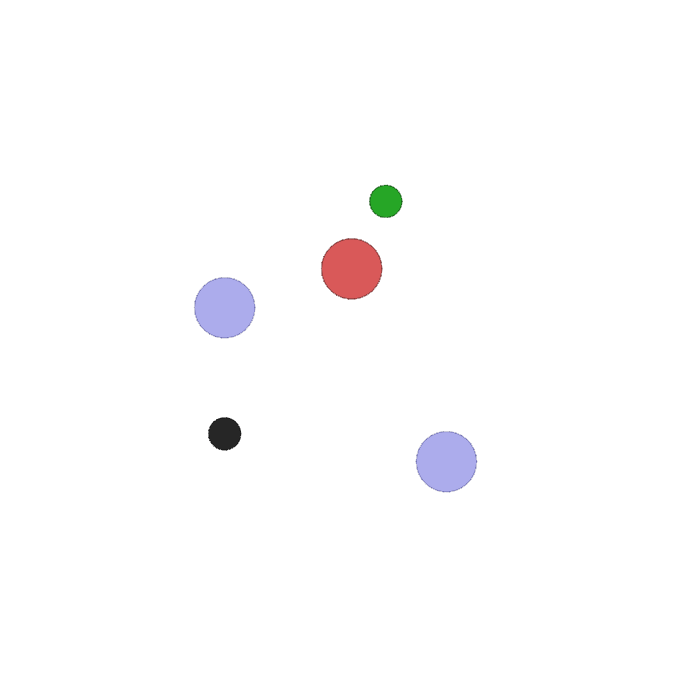Simple Adversary#

This environment is part of the MPE environments. Please read that page first for general information.
Import |
|
|---|---|
Actions |
Discrete/Continuous |
Parallel API |
Yes |
Manual Control |
No |
Agents |
|
Agents |
3 |
Action Shape |
(5) |
Action Values |
Discrete(5)/Box(0.0, 1.0, (5)) |
Observation Shape |
(8),(10) |
Observation Values |
(-inf,inf) |
State Shape |
(28,) |
State Values |
(-inf,inf) |
In this environment, there is 1 adversary (red), N good agents (green), N landmarks (default N=2). All agents observe the position of landmarks and other agents. One landmark is the ‘target landmark’ (colored green). Good agents are rewarded based on how close the closest one of them is to the target landmark, but negatively rewarded based on how close the adversary is to the target landmark. The adversary is rewarded based on distance to the target, but it doesn’t know which landmark is the target landmark. All rewards are unscaled Euclidean distance (see main MPE documentation for average distance). This means good agents have to learn to ‘split up’ and cover all landmarks to deceive the adversary.
Agent observation space: [self_pos, self_vel, goal_rel_position, landmark_rel_position, other_agent_rel_positions]
Adversary observation space: [landmark_rel_position, other_agents_rel_positions]
Agent action space: [no_action, move_left, move_right, move_down, move_up]
Adversary action space: [no_action, move_left, move_right, move_down, move_up]
Arguments#
simple_adversary_v3.env(N=2, max_cycles=25, continuous_actions=False)
N: number of good agents and landmarks
max_cycles: number of frames (a step for each agent) until game terminates
continuous_actions: Whether agent action spaces are discrete(default) or continuous
Usage#
AEC#
from pettingzoo.mpe import simple_adversary_v3
env = simple_adversary_v3.env(render_mode="human")
env.reset(seed=42)
for agent in env.agent_iter():
observation, reward, termination, truncation, info = env.last()
if termination or truncation:
action = None
else:
# this is where you would insert your policy
action = env.action_space(agent).sample()
env.step(action)
env.close()
Parallel#
from pettingzoo.mpe import simple_adversary_v3
env = simple_adversary_v3.parallel_env(render_mode="human")
observations, infos = env.reset()
while env.agents:
# this is where you would insert your policy
actions = {agent: env.action_space(agent).sample() for agent in env.agents}
observations, rewards, terminations, truncations, infos = env.step(actions)
env.close()
API#
- class pettingzoo.mpe.simple_adversary.simple_adversary.raw_env(N=2, max_cycles=25, continuous_actions=False, render_mode=None)[source]#
- action_spaces: dict[AgentID, gymnasium.spaces.Space]#
- agent_selection: AgentID#
- agents: list[AgentID]#
- infos: dict[AgentID, dict[str, Any]]#
- observation_spaces: dict[AgentID, gymnasium.spaces.Space]#
- possible_agents: list[AgentID]#
- rewards: dict[AgentID, float]#
- terminations: dict[AgentID, bool]#
- truncations: dict[AgentID, bool]#


